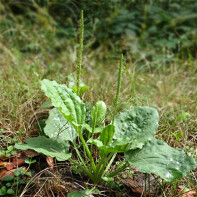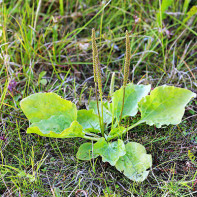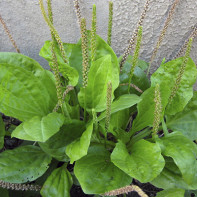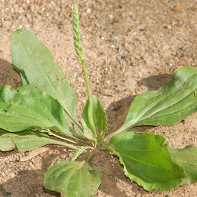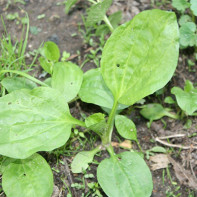Plantain: therapeutic properties and contraindications
The benefits of plantain are known even to children of kindergarten age. About the miraculous and sometimes magical properties of this amazing plant is sung in popular songs and told in folk epics. It may seem that this unsightly-looking plant, which resembles a banal weed, does not deserve such attention. But in reality, this modest herb in its composition and unique characteristics is many times superior to many of the brightest representatives of the plant world. And the scale of the plantain's distribution in the world allows it to be considered a cosmopolitan: after all, it can be found anywhere on the planet except the Arctic, Antarctica and the space of deserts.
- Chemical composition
- How it looks and where it grows
- Types of
- Harvesting and storage
- Therapeutic properties of plantain
- For Women
- For Men
- In Pregnancy
- For breast feeding
- For children
- For weight loss
- Plantain in folk medicine
- Diabetes mellitus
- For pancreatitis
- For gastritis
- For bowel
- For constipation
- For gout
- For colitis
- For the liver
- For hemorrhoids
- For cholecystitis
- For coughs
- For colds
- For cystitis.
- For asthma
- Infertility
- Types of medicinal compositions with plantain
- Infusion
- Decoction
- Tincture
- Syrup
- Tea
- Salve
- Juice
- Pharmacy preparations with Plantain
- Cosmetic applications
- Cleansing lotion
- Anti-inflammation and irritation
- Ice Cream Tonic
- Effective Hair Treatment
- Can I Feed Plantain to Rabbits
- Contraindications for use
Chemical Composition
The composition of plantain is a chemical formula, including both simple elements and complex compounds. In total, there are several dozen components in the set, so let's note only the main active substances. These include:
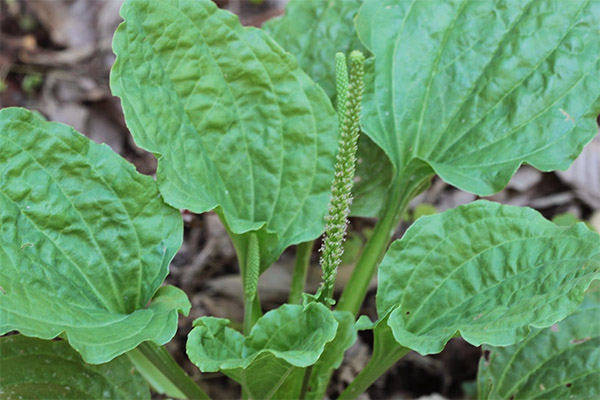
- Vitamin complex, represented by ascorbic acid, retinol (vitamin A), a group of fat-soluble substances known as vitamin K.
- Bioflavonoids, which are powerful antioxidants.
- Tannins.
- Minerals, including cobalt, molybdenum, selenium, magnesium, iron and a number of macro-and micronutrients.
- Alkaloids.
- Organic acids, including large quantities of uronic and citric acids.
- Nitrogenous substances.
- Phytoncides, which successfully cope with the role of destroying pathogenic bacteria and viruses.
- Slimes and bitterness.
- Glycosides, carotenes, enzymes and polysaccharides.
Important point! In the composition of the useful herb in microdoses there are many other elements that can have a beneficial effect on the human body. But the main feature is that all substances in interaction with each other increase the therapeutic effect.
How does it look and where does it grow?
The inhabitants of ancient Russia used the herbaceous plant to get its meaningful name due to its peculiarity to settle along the roads. In Latin plantago literally means "to move the sole", which, however, also reflects plantain's predilection for certain habitats. Other names of plantago include triputnik, slashing plant, teal grass, and seven-stranded fellow traveler. Often the plant is called roadside plantain, which is consonant with the botanical version of the name of this crop.
Among the huge species diversity there are annual and perennial species. The species belonging to perennial herbs are more widespread, less often you can find a semi-shrub plant.
The appearance of roadside plant can hardly be called attractive. Its large oval leaves at the root are gathered in a rosette. During flowering, an arrow-shaped spike forms, which is literally dotted with tiny brown inflorescences. Under favorable conditions this arrow can reach a height of 30 cm or more. The fruits are seeds collected in a capsule.
Back in pre-Christian times, plantain was widespread throughout European territory. Subsequently, Europeans brought the herb to North America, where it successfully took root. Interestingly, the natives of the Western Hemisphere call the herb "white man's footprint", which, in fact, reflects this historical fact.
Plantain is undemanding to the conditions of existence. It feels great on vacant lots, near ponds, in thickets of wild bushes and in dacha plots. Such adaptability contributes to the spread of grass, which creates certain problems for dacha owners.
Species
About two and a half hundred species of the plant grow in the wild, most of which belong to the perennials. Despite belonging to the wild crops, it is these species that are in demand in the pharmaceutical industry. For example, the most common variety of medicinal plantain is a large plantain grown specifically to obtain valuable raw materials. It is distinguished by the fact that it can reach almost half a meter in height. This is perhaps the most prominent representative of the Plantain family. It has large leaves of rounded shape.
Other common species of roadside plantain:
- Lancet species. Distinctive features of the plant are sharp leaves with long petioles, a dense spike of inflorescences. This species develops well in dry soils and tolerates hot climates very well. In folk medicine it is used as widely as the related great plantain.
- The medium species has toothed leaves with short petioles. The plant is capable of throwing flower arrows up to 50 cm in size and produces flat seeds.
- Flea or sandy variety is an annual. This plantain has a branched stem up to 40 cm, covered with a pubescence. In medicine, the seeds of the plant, which contain an enormous amount of mucus, are mostly used. The stems and leaves are used to make sap, which is also highly valued in pharmacology.
- The marine species is less common. Such plantain grows near water bodies. The plant is easily recognized by its thin oblong leaves, pointed at the ends.
All of the above species of plantain can be found almost anywhere in the world, but the largest areas the plant occupies in the expanses of Russia and the CIS countries.
Interesting fact: The flowering period of the plant depends on the species of grass and the growing area. But usually it starts in June, in September the fruits already appear.
Collection and storage
Domestic herbalists have accumulated great experience with plant material. Most of these developments have been inherited from previous generations of healers. By the way, scientists often take into consideration such a historical heritage. On its basis, the rules of harvesting useful herbs were developed:
- To collect plantain leaves, the period from May to June is ideal. A pair of scissors is recommended, for gently cutting the leaves without damaging the root of the plant.
- The best time to harvest the seeds is when they are fully ripe. To this end, the entire flower stalk, or spike, is cut off.
- The roots are dug out in early spring before flowering or in late autumn.
- As one of the plantain's characteristics is its ability to absorb toxic products, you should not harvest the raw material in large industrial plants or near highways.
- It is recommended to dry plant material in attics or under sheds, avoiding direct sunlight. Leaves are usually spread in an even, thin layer. From time to time we shake the material so that the leaves dry evenly and don't get stale.
- Cracked petioles are an indicator that the raw material is ready.
- Well dried raw material is packed in woven bags and put in storage in a dry place with no light.
- The optimal shelf life of the naturally dried plantain is 2 years.
An addition: Plantain leaves can be not only dried, but also frozen. For this purpose, the freshly harvested herbs are immediately packed in bags in small portions, and then placed in the freezer. But the storage period of such raw materials is reduced to six months.
The therapeutic properties of the plantain
The medicinal properties of plantain were actively used even in ancient times. This fact is confirmed by the description of the useful plant in the first works on medicine of the famous Avicenna. Medicinal forms with its participation were prepared by eastern healers. Such preparations were used to treat colds and more serious diseases, such as ulcers.
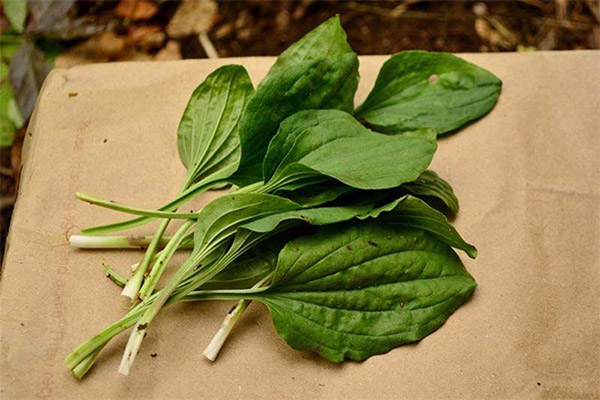
Plantain-based remedies have also found wide application in modern medicine. The pharmaceutical industry produces a full line of effective medications for treating a huge number of ailments. Traditional healers keep up with the official medicine, offering the population time-tested, simple but very effective recipes based on this herb.
In the list of healing properties, which made plantain famous, the following therapeutic actions:
- sedative;
- antiseptic;
- wound-healing;
- enveloping;
- expectorant;
- emollient;
- styptic;
- anti-allergic;
- hypotensive;
- regenerative;
- anti-inflammatory;
- tonic;
- bronchodilator;
- analgesic;
- diuretic;
- antiphlogistic.
To these effects we can add the ability of plantain to regulate sugar and cholesterol levels, as well as to stimulate the production of digestive enzymes.
Plantain has also been proven by scientists to have anticancerogenic properties, making it a good cancer-preventive agent. Herb preparations are often recommended for patients after chemotherapy and radioisotope treatment to reduce side effects.
For women
Plantain herb is very useful for women's health. First of all, it is valuable because it can have a positive effect on the reproductive capabilities of patients suffering from infertility. For this purpose, the seeds of the plant are used, which are saturated with essential components. Leaves and roots are used in the treatment of inflammatory processes of the genitals. There are many positive examples of treatment of cervical erosion with solutions for douches based on the medicinal herb.
For internal use, infusions and alcoholic tinctures are prepared. Such remedies improve blood clotting, which is necessary for intensive uterine bleeding. In addition, remedies with plantain have pronounced analgesic properties. Therefore, it is recommended to drink them when you have painful periods.
For men
For representatives of the strong half of mankind, plantain is a must. The seeds of the plant, if on their basis to make a decoction, will help to get rid of infertility. Healing herb also has a positive effect on potency, and to cure persistent impotence will help effective folk recipes using the roots of the plant. In addition to the fact that plantain improves blood flow, it stimulates spermatogenesis. With the competent use of this natural gift, any man will be able to prolong an active sexual life, as well as improve its quality.
In pregnancy.
Although during pregnancy a very strict approach to the choice of medicinal herbs, the decoction of plantain is not forbidden for the future mother to drink, if it does not pose a threat to the developing fetus. As a rule, home remedies with the herb are useful for the following pathological conditions:
- respiratory infections;
- constipation;
- digestive disorders;
- Wounds on the skin and mucous membranes (for external treatment);
- toothache (for gargling).
Of course, when prescribing any kind of treatment with herbs to pregnant women, it is necessary to take into account the presence of contraindications. If a woman has problems with blood clotting, thrombophlebitis or acute diseases of the gastrointestinal tract, it is forbidden to take such preparations.
When breastfeeding.
Plantain seeds are full of polysaccharides and mucus, which is good for the intestines. These substances have a mild laxative effect. Therefore, breastfeeding women with bowel emptying problems can drink decoctions and water infusions. Since such drugs are not absorbed by the intestinal mucosa, they do not enter the blood plasma and breast milk. From this we can conclude that the treatment of the mother with plantain is absolutely safe for the baby.
For children
Any kind of treatment for children has certain limitations. Home therapy with herbs is no exception. Plantain is part of many folk remedies for coughs, but you can give them to a child only after three years. As for remedies for external use, in this case, the age limit is reduced to one year. From this age, it is allowed to give babies a pharmacy cough syrup. The most popular product in this line is Herbion, which helps with dry coughs. The drug "Mucoplan" is worth giving sick kids with a wet cough for better expectoration of sputum. All dosages are listed in the annotation to the medicines.
Homemade decoctions based on plantain can be given for therapeutic purposes with acute cystitis in children after 5 years. Tea with the healing herb will benefit the immune system of the child, and help to establish intestinal function. To neutralize the bitter taste of such drinks, you can add a little honey, if the baby is not prone to allergies.
Important! Children suffering from diabetes and atopic dermatitis, plantain syrup should not be given.
When losing weight
The ability of plantain herb to normalize the work of the intestine and improve the course of metabolic processes is actively used in the fight against excess weight. Usually prepare a decoction from the seeds of useful plants on a standard scheme: a tablespoon of plant raw materials in a glass of steeped boiling water. After half an hour of infusion, drink the drink on an empty stomach. The norm for one reception is 1/3 cup. Of course, such a remedy is considered only as an auxiliary therapy, but not as an independent type of treatment.
Plantain in folk medicine
In folk medicine, plantain has been used since time immemorial. But the most interesting thing is that on different continents people prepared almost the same medicinal forms from this useful vegetation. This once again proves the fact that the first aesulaps already in ancient times conducted research, studying the composition and useful properties of medicinal herbs.

The Slavs generally considered plantain as a panacea for all diseases. In those distant times, sick people, regardless of class, used the roadside plant to treat a simple runny nose and non-healing wounds. Modern healers cherish the ancient recipes of folk healers, and if necessary, recommend them to sick people. The versatility of the plantain today has been confirmed by research. This simple plant has a really unique set of medicinal properties, so it can be used for different pathological conditions.
For Diabetes Mellitus
Plantain has been used to treat diabetics since Roman times. But any preparations based on the herb are used as an effective supplement. Especially useful is this plant for complications of diabetes, which often accompanies this disease. Thanks to its regenerative and anti-inflammatory properties, with the help of simple compositions with plantain it is possible to treat non-healing ulcers, digestive disorders. As a rule, fresh juice of the plant is used to prepare compositions, which are taken in pure or diluted form on an empty stomach. You can also drink infusions of the herb. But such therapy is possible if the patient has reduced acidity of the stomach.
When pancreatitis.
To relieve acute attacks of pancreatitis, the use of compositions with plantain is strictly forbidden, but to restore the normal functioning of the pancreas, such preparations are ideal. Usually doctors recommend such compositions in addition to the main complex of therapy. The result of this type of treatment is based on the ability of roadside herbs:
- Localize foci of inflammation.
- Stimulate the restoration of the affected tissues at the expense of the body's own forces.
- Relieve spasms by relaxing the muscles of the tissues.
- Restore the normal functioning of the diseased organ.
- Due to the targeted action of plantain remedies, achieve a persistent remission, as well as reduce the risk of recurrent relapses of the disease.
It should be recalled that any kind of self-treatment in such a serious disease as pancreatitis can lead to unpredictable consequences. Therefore, any options for auxiliary treatment can be applied in practice only after approval by a doctor.
With gastritis
The use of plantain is justified in any form of gastritis, but most often the preparations with its participation are recommended to complement the complex of therapy for reduced acidity. Relevant are any dosage forms, you can apply pharmacy remedies without fear. The main therapeutic effects that triputnik demonstrates in the treatment of gastritis:
- eliminates the signs of inflammation;
- relieves spasm;
- reduces the intensity of painful sensations;
- promotes rapid recovery of normal functions of the entire digestive system;
- restores the normal balance of microflora;
- destroys pathogenic microorganisms;
- stimulates the healing of damaged tissues;
- eliminates discomfort in the epigastrium;
- normalizes the level of acidity.
Important point: Plantain is undesirable to use in some forms of peptic ulcer disease. For this reason, it is necessary to undergo an examination before treatment.
For the treatment of gastritis, it is better to use fleabane and large plantain.
For the intestines.
As with other organs of the digestive tract, plantain is good for the intestines. It contains components that increase peristalsis, which creates favorable conditions for regular stools. The antibacterial properties of the healing plant get rid of pathogens, restoring normal microflora. In addition, medicines with roadside herbs eliminate flatulence, relieve intestinal colic, and also have a pronounced calming effect.
In case of constipation
In chronic constipation, it is advisable to use plantain seeds. They can be used in pure form in small portions - a tablespoon on an empty stomach. To activate the therapeutic effect, it is recommended to wash down such a herbal medicine with warm water. As a rule, the effect is manifested in 8 hours. Universal laxative is considered the husk of seeds and fresh juice, on the basis of which a laxative decoction is prepared. However, you should take into account that such a medicine is recommended to drink immediately after it is prepared.
With gout
A characteristic feature of gout is a violation of purine metabolism, which leads as a result to an increase in the concentration of uric acid in the blood plasma. In turn, this entails the deposition of urate in the cartilage tissues. The chemical composition of plantain contains a group of substances that promote the removal of harmful salts from the body. Therefore, with the permission of your doctor, plantain must be included in the treatment of gout. You can use both fresh and dried plant material: leaves and seeds.
Systematic courses of treatment involving preparations based on plantain will help prevent dystrophic changes in the joints. But the intention to carry out treatment with plantain, the patient must necessarily agree with the doctor.
With colitis
Colitis - this is quite an unpleasant disease, which gives a person significant discomfort. But, in addition to unpleasant sensations, inflammation of the mucous membranes of the large intestine leads to a serious disruption of digestive functions. In such a situation, plantain is able to provide effective help. For example, an infusion of the plantain seed, prepared according to the classic recipe will relieve cramps and colics, relieve pain, which often accompanies acute colitis.
But the main advantage of preparations based on plantain grass is its antibacterial properties. After all, at the heart of any inflammatory process is the fact of penetration of pathogenic bacteria. Plantain copes well with the task of destroying "uninvited" guests. It quickly removes inflammation, activating the repair of damaged tissues.
For the liver
Since plantain is able to activate the enzymatic functions of the digestive organs, its benefits for the liver are beyond doubt. And for therapeutic purposes, you can use any dosage form: infusion, juice, decoction. Even cirrhosis of the liver and hepatitis can be treated with the help of folk recipes. Home remedies with plantain will soothe pain, relieve spasm, relieve the heaviness in the right subcostal area.
In hemorrhoids
Hemorrhoids are one of the most insidious diseases, which not only causes discomfort to the person, but also significantly reduces the quality of life. Sometimes the pain is so severe that the patient has to take strong medications to relieve it. Through the use of plantain, such patients can remove a number of serious problems from the agenda:
- get rid of pain;
- speed up the healing of cracks and wounds in the delicate area;
- restore normal bowel functions;
- relieve swelling in the anal area;
- Stop bleeding, which often accompanies an exacerbation of the disease.
With hemorrhoids, internal intake of decoctions and infusions with plantain, as well as local treatments: lotions and ointments helps. Microclysters with warm decoction of the herb are effective.
It is useful to know: in the encyclopedia of folk recipes you can easily find a way to prepare rectal suppositories with plantain. The combination of such suppositories with microclysters speeds up the healing process.
In cholecystitis
With inflammation of the gallbladder, patients complain of severe pain, heaviness, especially after eating fatty foods. To relieve the negative symptoms and signs of inflammation of the organ, it is possible by simple home remedies with a cutter. The optimal option is a tincture of fresh leaves, which is drunk in small portions for an hour. The remedy is prepared according to the formula: per glass of boiling water one large leaf of the plant.
From coughs
With a cough of any nature of origin, it is worthwhile to use the healing properties of the plantain. The components of the plant have simultaneously a soothing, anti-inflammatory, astringent effect, provide a rapid removal of sputum. With dry unproductive cough, homemade decoctions with the herb ease the attacks. Therefore, preparations with plantain are considered the No. 1 remedy for colds, bronchitis, laryngitis. Such medicines are effective even for tuberculosis.
For colds
At the first signs of any cold, experienced parents immediately think of plantain. The good thing is that in the pharmacy you can buy ready-made syrup or cough pills, which include the healing plant. A huge popularity, especially among young patients, use cough drops, and adults prefer to prepare at home alcoholic tinctures with the herb. In the reference books of herbalists there is a recipe for a tincture of the root of the plant on red wine. This remedy is very effective for herpes. It is taken internally, as well as make lotions on the skin area with herpetic rash.
When cystitis
In inflammatory processes of the urinary system, preparations with plantain are not included in the list of drugs of first choice. But they give excellent results in the treatment of nocturnal enuresis and polyuria (frequent urination).
For asthma
The ability of the healing plant to reduce the intensity of coughing during attacks of bronchial asthma helps to normalize breathing, and also contributes to the removal of accumulated sputum. You should also consider that the composition of the herb contains useful vitamins and trace elements that strengthen the immune resource. As an auxiliary medicine to the complex of basic therapy, you can take a warm decoction of plantain leaves or syrup.
Infertility
Both in male and female infertility, the seeds of plantain are used. On their basis prepare therapeutic decoctions or infusions. However, to achieve a positive result will require a long course of treatment.
Types of medicinal compositions with plantain
Folk healers in their practice widely use various medicinal forms, the main component of which is plantain herb. These centuries-tested formulations are available to the interested audience. Most remedies are prepared according to the classic scheme, but there are more advanced recipes. Here are some recipes for practical use at home.
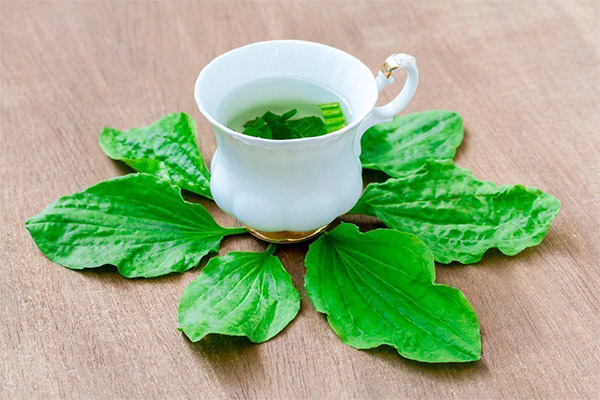
Infusion .
To prepare an infusion, fresh plant material or dried parts of the plant will do. The medicine is prepared in the following sequence:
- If fresh leaves are used, they must be thoroughly washed and dried. It is desirable to crush them. After that, pour a tablespoon of raw materials into a teapot, and pour a glass of boiled water (95 degrees). The container tightly covered with a lid, so that the solution infused. After a quarter of an hour, strain the composition, and then take as directed.
- The second popular way of preparation is the use of a thermos. In this situation, the scheme is relevant: per liter of boiling water, 4 tablespoons of plant material. After an hour of infusion, the medicine can be drunk.
Decoction
The process of preparing a decoction does not differ in complexity. For this purpose, it is better to use an enamel bowl. First, you need to pour a glass of water into a container, add 3 tablespoons of crushed dry herbs, bring to a boil, and then keep on low heat for another 25 minutes. Cooled decoction to take internally in a prescribed dosage, or use for external procedures. To relieve pain, prepare a decoction of plantain inflorescences in the same proportions.
Note: decoctions, as well as infusions, should be prepared daily, it is not recommended to store such medicines.
Tincture
The advantage of medicines prepared on an alcohol basis is that they are stored for months. Tincture of plantain can be made on vodka or on homemade moonshine. It is preferable to use fresh herbs, but dried material bought at the pharmacy will do. Raw material is recommended to grind with a blender or pass through a meat grinder, squeeze the juice, and then combine in equal parts with an alcohol-containing product. The period of infusion - from 10 days to three weeks. The finished tincture should be poured into a bottle with a tightly lapped cork. Store the medicine best in a cabinet, but you can also in the refrigerator.
Syrup .
There are several ways to prepare plantain syrup.
- In the first case, add sugar to the freshly squeezed juice of the plant.
- The second option involves the use of honey, which increases the therapeutic qualities of the drug.
The syrup is prepared only from fresh grass, which is crushed using a blender, and then the juice is squeezed. Store the syrup is recommended in a glass container no more than three months. The best place to store the drug is the refrigerator.
Tea
A tea drink is prepared from dried seeds. For one cup, it is enough to take a tablespoon, pour the base with boiling water. After half an hour of infusion, you can drink the useful drink. Specialists recommend dividing the entire volume into three meals. In addition to the seed of the plant, dried roots and leaves can be used to prepare the healing tea. In any case, one scheme is applicable - a spoonful of raw materials per glass of water. If you need to get a concentrated drink, the portion of plant material is doubled.
Useful tip: The seeds should be held in warm water before use, so that they swell.
Ointment
Ointment for external use is prepared from dried leaves. First you need to grind them to powder, then pour them into a jar, so that the base took up half the volume of the container. After that, you can add about 120 ml of coconut oil. Define the composition on a water bath, where it should languish for at least two hours. After straining, add 15 g of beeswax to the still warm mixture. Store the finished ointment in a cool place.
Juice
The method of obtaining plantain juice is detailed in the recipe for making syrup. That is, the green mass should be processed using a meat grinder or blender, and then squeeze the juice. If you get too thick juice, you can dilute it by half with water. Ready extract necessarily subjected to boiling. To improve the taste, you can add honey.
Pharmacy preparations with plantain
In the pharmacy network you can find preparations, which include plantain. Attract such means are low cost and effectiveness of application. In the list of the most popular remedies:
- Cough syrups and tablets. As an example, it is worth mentioning a popular remedy "Gerbion", which is available in the form of a syrup. The medicine is indicated for bronchitis, dry cough. The drug is approved for the treatment of children.
- Herbal gatherings with plantain can also be freely bought in any pharmacy. For example, plantain with the herb mother and stepmother is excellent for treating colds.
- Natural plantain juice is prescribed by doctors to adult patients, since the preparation is prepared on an alcohol basis, for inflammatory processes of the respiratory tract. The product is suitable for external treatment of the affected areas of the skin.
- Water extracts can also be found on pharmacy shelves. Particularly popular is the drug Pantaglucid, which is used to treat gastritis, hemorrhoids, ulcers and other gastrointestinal pathologies.
- Suspensions and powders with plantain are also in demand among customers. They can be prepared by yourself at home, but it is better to buy a ready-made drug in the pharmacy. The most famous remedy for constipation and anal fissures is "Fibrolax".
Applications in cosmetology
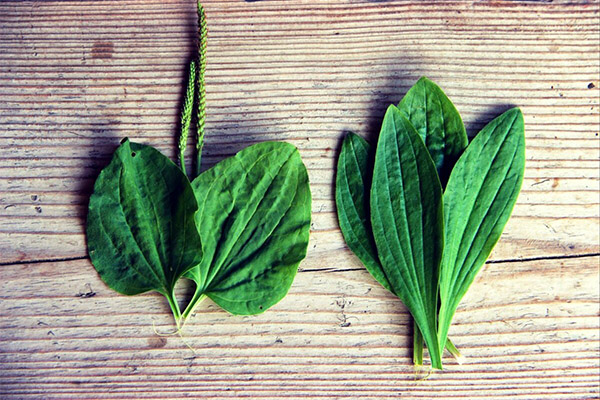
In the beauty industry, plantain herb is no less in demand than in medicine. This valuable plant material is included in many facial skin and hair care products. The medicinal plant forms the basis of special creams and ointments used to eliminate dermal problems: acne, increased oiliness, wrinkle elimination. In addition to its ability to combat any manifestations of inflammation, roadside plant is useful for the following actions:
- tightens the skin;
- cleanses pores;
- moisturizes and tones;
- evens out the tone of the face;
- It is effective in the treatment of corns;
- Strengthens hair;
- softens the skin.
For cosmetic home treatments, you can use fresh herbs and dried raw materials. Below are a few simple recipes that will help improve the condition of the skin and hair.
Cleansing lotion
This remedy for everyday care is suitable for problematic skin. To prepare the composition you will need:
- alcohol - 20 ml;
- Dry plantain (you can replace the freshly picked leaves) - 2 tablespoons;
- Water - 1/2 cup.
If the basis is taken fresh herbs, they must first be chopped. Then pour boiling water over the raw material for half an hour, then strain and mix with alcohol. Store the lotion in a cool place. Treat the problem areas twice: in the morning and in the evening.
To prepare a cleanser, you can take the juice of the herb, mixing it with vodka, diluted in a ratio of 1:1 water.
Against inflammation and irritation
You can relieve inflammation and irritation with applications. The procedure is carried out in the following sequence: wash the leaves with warm water, first crush them so that they become a pulp, then the green mass is applied in an even layer to the affected areas.
Ice tonic
First you need to prepare a concentrated infusion of roadside herb (2 tablespoons of plant raw materials per glass of water). When the infusion cools, pour it into ice molds, so that then every morning the cubes can be used instead of the traditional washing. Regular use of this procedure noticeably improves microcirculation, improves skin elasticity and makes the face look young and fresh.
Effective remedy for hair
Get rid of dandruff and strengthen the hair will help plantain juice, obtained from fresh leaves. Of course, to obtain the required amount of green mass will have to try, because a whole glass of juice will be required. The healing nectar should be rubbed into the scalp, and after two hours rinse the hair with warm water. Increase the attractiveness of the hair decoction of the herb, prepared from 2 tablespoons of leaves brewed in a liter of water. The composition should boil on a low heat, and then insist for another hour.
The resulting remedy is recommended to rinse the hair after washing.
Is it possible to give rabbits plantain
It is known that rabbits are big fans of natural vegetation. But like any other pets, these cute animals need a balanced diet. This is a prerequisite that must be met by a caring owner who wants to provide themselves with tasty dietary meat and beautiful fur. Plantain should definitely be included in the menu of furries, as this plant is a unique source of a mass of useful substances. The grass is full of vitamins and fiber, and there are proteins necessary for the health of rabbits.
However, collect grass for feed should only be in ecologically clean places, and before using such feed, it is necessary to wash it with water and then dry it. Wet grass should not be given to rabbits. Plantain is best included in green mixtures. It is preferable to take young plants for animal feed.
Contraindications to use
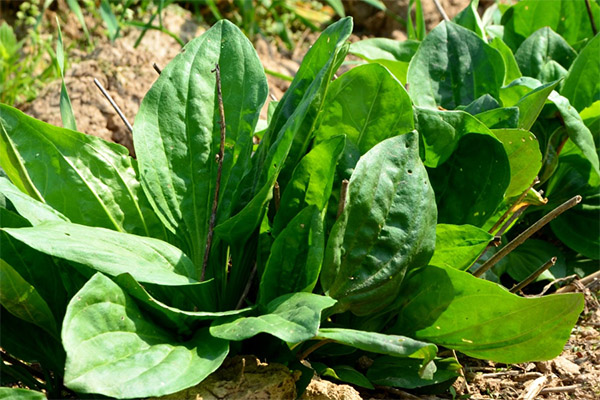
Although plantain is considered one of the safest types of vegetation, in some cases it should not be used for treatment. The list of contraindications includes:
- GI diseases in the acute stage;
- thrombophlebitis;
- susceptibility to allergic manifestations;
- blood clotting problems;
- Individual intolerance.
In other cases, the plant can be used without fear, including it in healing mixtures. But any type of treatment should be based on strict compliance with the treatment regimen and the dosages specified in the recipe.
«Important: All information on this site is provided solely for introductory purposes only. Before applying any recommendations, please consult with a specialist. specialist. Neither the editors nor the authors shall be held liable for any possible harm caused by materials."

